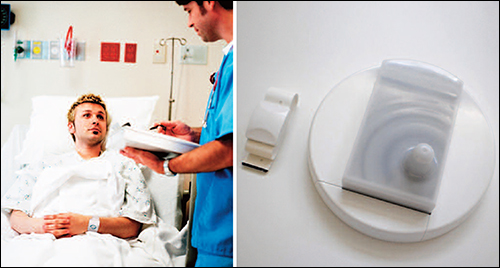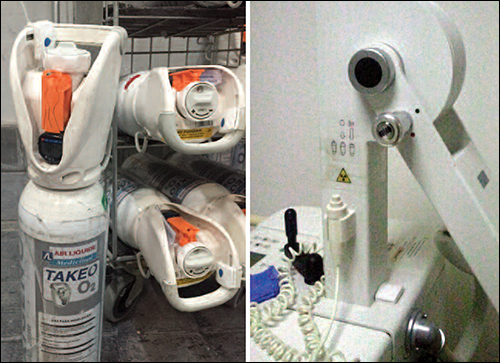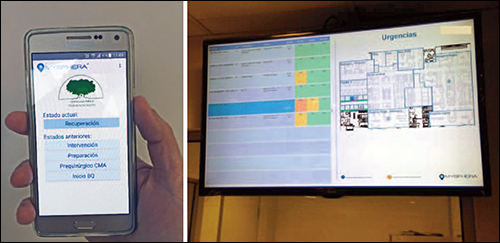Synergy is the byword at Hospital de la Vega, a private hospital in Murcia, Spain, that provides basic medical services and specialized procedures such as extracorporeal cardiac surgery.
In 2015, Hospital de la Vega conducted a pilot of the MySphera Internet of Things (IoT) platform that integrates data from various sources, including electronic health records (EHR), health information systems (HIS), lab and X-ray systems, and a real-time location system (RTLS) that tracks patients and assets. The IoT platform puts all the data in context and makes the information easily accessible, whenever and wherever it’s needed. Physicians, nurses, clinicians and hospital administrators can use the information to make smart decisions in real time, to improve processes and patient care, lower costs and deliver better communications to patients’ families during medical procedures, says Hospital de la Vega’s CEO Carlos Arenas.

Before implementing the IoT platform, Hospital de la Vega suffered from low synergy across information sources, Arenas says. Health-care workers would have to go to workstations and log into separate systems to get patient information, such as blood type, medications or status of test results, and to locate medical devices in an asset database. They didn’t always know where particular patients were at any given moment, or how long they had been in particular parts of the hospital. It was difficult to find the closest portable X-ray or other life-saving equipment. Without information synergy, they weren’t able to fully understand all the facets of a particular case or issue when decisions had to be made to treat patients who required immediate care.
Hospital de la Vega was selected as a pilot site to use MySphera because the hospital’s management team embraced the IoT concept. MySphera is part of the Future Internet Challenge eHealth (FICHe) project, which encourages European health organizations to develop innovative applications using FI–Ware open-platform technology. The project was funded by the European Union.
“MySphera would be able to validate the system in several hospital processes—including hospitalization, emergency, surgery, equipment—with the chief of services’ support and commitment,” says Elena González, chief of emergency nursing, who led the MySphera implementation for the hospital’s emergency department.
Today, Hospital de la Vega caregivers and administrators use dashboard applications on tablets, large-screen TVs or PCs to securely identify and control the flow of patients and assets. MySphera also provides business intelligence tools that hospital managers use to visualize workflows and analyze data. The solution has led to cost reductions from shorter patient stays and revenue increases from improved patient throughput. Surveys conducted by the hospital to measure the impact of the IoT project reveal high levels of staff, patient and family satisfaction, Arenas says. Staff members have a greater sense of control over processes and equipment, he adds, and more trust in the information provided for improving processes.
The IoT Infrastructure
The FI-Ware platform—an enhanced OpenStack cloud environment plus a set of standard application program interfaces (APIs)—underlies the cloud-based MySphera RTLS. It functions as a horizontal hospital process-information system for merging data from different sources. “The MySphera IoT system proposes a completely new technical design, so it can be easily and cheaply deployed in any environment without high up-front investment using technologies that can be useful for many applications,” Arenas says.
But before the IoT platform could correlate personal and process information, Hospital de la Vega had to be able to track patients and assets. The hospital deployed MySphera’s RTLS, which uses Bluetooth Low Energy (BLE) tags on patient bracelets and mobile assets. MySphera’s USB tag desktop reader for workstations links the assigned patient or asset tag identification number with patient information in the solution’s MyHospital software and the hospital’s HIS and EHR system.
MySphera’s BLE beacons were installed in the ceilings in the emergency department, surgical, internal medicine and social wards, and in the major ambulatory surgery center. The 130 beacons identify the tags, which function as emitters and receivers, from several meters. Unlike some BLE systems, MySphera does not incorporate Wi-Fi technology. The beacons were connected via Ethernet cable to the SpheraOne location server, which includes an algorithm that calculates the position of a tag with respect to predefined location areas using the data received from the beacons.

Any mobile device that supports BLE standards is a potential mobile beacon, too, since it can receive a tag signal and identify the assigned person or object. Although the solution uses standard Bluetooth, “access to the information is secure,” says MySphera’s CEO, Salvador Vera. “The solution uses a proprietary frame sent by tags—we don’t use, for example, Apple’s iBeacon specification—therefore, you need a specific application in the mobile device in order to scan the tag.” Additionally, he says, the tag only sends information about itself, such as its ID, never any personal data about the patient.
The central information hub is the FI-Ware Orion Context Broker (CB), an API that correlates information from different sources, including MyHospital, SpheraOne and workflow engines monitoring lab tests and other processes. The EHR provides health-care data for medical and nursing services, triage and procedures, and the HIS provides administrative data such as name and bed. FI-Ware’s Geo-fencing API is used with MyHospital for indoor location tracking information and for publishing those events to CB. Multiple devices can access the unified information via queries or subscriptions to information changes to get push updates.
MySphera is designed to operate independently, so it doesn’t interfere with a hospital’s communication networks or Wi-Fi infrastructure. There is no need for modifications to previously integrated software components, which Vera says is a distinguishing feature of the system. The installation at Hospital de la Vega took eight weeks, he says. The battery-powered tags on patient bracelets last roughly 1.5 years; those on mobile assets last approximately 4 years. The system, including activating firmware on all devices, is remotely monitored and maintained, he says.
MySphera was an optimal solution for the hospital because the vendor is “involved in the use of the open-source technology FI-Ware,” Arenas says. “MySphera is the company that has more experience and development in this field in Spain.” MySphera is a cloud service, so Hospital de la Vega gains the benefits of high scalability in a pay-per-use software-as-a-service model, he adds.
Anytime, Anywhere Information
During the pilot, conducted from April through December, incoming patients received bracelets with BLE ID tags. Each day, approximately 100 patients were treated in the emergency department; 80 patients on surgical, internal medicine and social wards; and 10 in the major ambulatory surgery center. Roughly 100 assets, including IV pumps, monitors and beds, were tagged. More than 250 staff members and patients’ families participated in the pilot.
Health-care workers used smartphones, tablets and Bluetooth-enabled devices on nursing trolleys to quickly scan the BLE ID tags on patients’ bracelets to confirm patients’ identity, verify they were at the right place at the right time, and ensure they received the correct medications. The tags were also used to check patients into operating rooms and identify their physicians.
Dashboard apps were designed to be viewed on large-screen TVs, PCs or tablets. Three large-screen TVs were installed at nursing stations on the wards, two in operating-room staff areas and two in emergency unit staff areas.

The dashboards were configured to display patient information for each unit, including emergency (pediatrics, adults and X-ray), surgery (ambulatory, programmed and emergency) and hospitalization (patients and bed map). The information included name, triage/procedure/bed, location, state in the process, time in the process and key performance indicators (KPIs) by color. If, for instance, a patient was flagged as being in the most critical state, the business process called for the patient to be seen for the first time within five minutes; if that became 10 or 15 minutes, the dashboard status turned from green to yellow and then red.
Doctors, nurses and hospital porters viewed the dashboards to see, for example, if a patient was waiting for a first visit from a doctor or if the patient was in the X-ray room awaiting or taking an X-ray or had completed the X-ray and was ready to return to the emergency unit.
During the pilot, for example, a physician sent an emergency-room patient to the X-ray facility for a test, González recalls. “After some time, he looked at the big dashboard to know where the patient was,” she says. “The physician saw the patient was waiting at the right place, so he called the X-ray department to accelerate the test.”
ER nurses also relied on the real-time dashboards to learn where patients were when doctors neglected to tell them they’d sent the patients to observation wards. That saved nurses from having to look for patients, so they could devote their time to caring for the patients still on their watch.
A large dashboard was deployed in the ER and OR waiting rooms, too; it identified patients by code rather than name to maintain their privacy. “Relatives in the waiting rooms of emergency and surgery units talked about the tranquility it provided them to know where the patient was and in which moment of the process,” González says. Approved family members and friends could download a MySphera app from Google Play to a BLE mobile device to check a patient’s status.
Hospital managers used business intelligence dashboards on mobile and fixed computers to analyze workflows, based on patient and asset location data as well as patient status within testing processes and patient administrative and health information. Managers could view, for example, average surgery and recuperation times per procedure, and average hospital stays per procedure, and have the system merge and measure the data against KPIs established by the hospital.
The data analysis enabled managers to gain insights into clinical and operational processes to more effectively assign hospital workers to specific tasks, reducing bottlenecks, mistakes and stress that result from staff shortages and high workloads. The emergency department, for example, reduced wait times by 12 percent. In comparing previous manual data entries with MySphera’s automatic real-time data, the hospital’s OR coordinator found a 15 percent deviation in surgery planning. Hospital administrators also used the data to improve bed management.
The project, which is ongoing, has been extended throughout Hospital de la Vega. Now that all mobile assets have been tagged, quantitative measurements include a 20 percent reduction in time searching for equipment. The hospital’s financial director calculates a 7 percent savings in capital expenditures per year from reducing equipment losses and improving usage rates, Arenas says.
Both Arenas and González believe the main challenge to getting the MySphera IoT solution up and running was related to change management. “The staff in the hospital has very different profiles, levels of studies and ages,” González says. “They were used to working in a certain way, and it was difficult to change it.” While the system requires hospital workers only to assign and remove tags, that process can add to work challenges in units where the flow of patients is very high. Sometimes, for example, ER workers would forget to remove tags from discharged patients’ bracelets. It was important, Arenas says, that the hospital board fully supported the project, communicated the benefits to staff members and enacted a thorough training plan to foster adherence.
“The MySphera IoT platform has proven to be a leapfrog in our internal health IT systems by connecting smart sensors with our hospital applications to improve the quality of care for our patients, our staff effectiveness and our operational costs management—easily and decisively,” Arenas says. “In addition, the growth possibilities are manifold, with impacts beyond the better care for our patients, such as highly impacting our health-care organization operational KPIs, at a lower total cost of ownership overall.”

